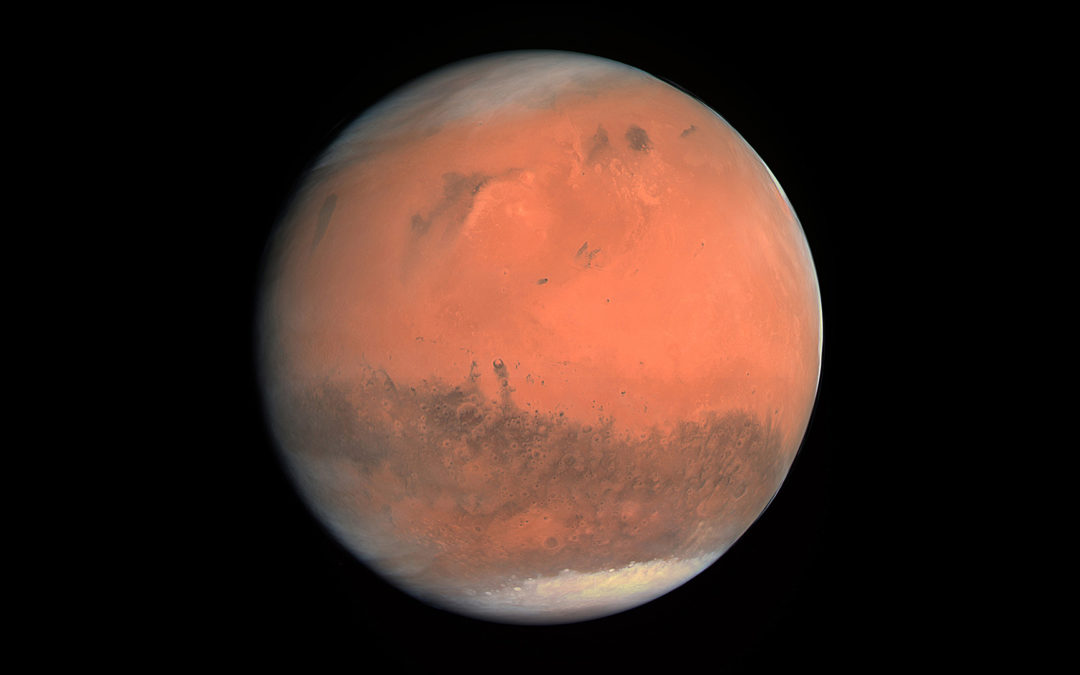“At most terrestrial men fancied there might be other men upon Mars, perhaps inferior to themselves and ready to welcome a missionary enterprise. Yet across the gulf of space, minds that are to our minds as ours are to those of the beasts that perish, intellects vast and cool and unsympathetic, regarded this earth with envious eyes, and slowly and surely drew their plans against us.” So begins the H.G Wells classic science fiction novel War of the Worlds in which technologically advanced Martians invade the Earth. More than any other planet, Mars has captured the imagination of science fiction enthusiasts. Why is this?
Driven at least in part by the belief that life on Earth was an accident of evolution, many scientists of the nineteenth and early twentieth century expected life had evolved on other worlds as well. Consequently, the consensus expectation at the time was to find a universe teaming with life. Early hopes of finding life on the moon or Mercury were dashed when these little worlds were found to have virtually no atmosphere, and extreme temperatures that would be lethal to any conceivable form of life. Venus held on a while longer; its enigmatic surface permanently enshrouded in thick clouds allowed for endless speculation unfettered by inconvenient data. But when Venus was discovered to have a surface temperature that can reach 900 degrees Fahrenheit, most astronomers reluctantly gave up on the notion of finding life there.
But Mars is strangely earth-like. It’s rotational period and axial tilt closely approximate those of Earth, resulting in day-night and seasonal cycles similar to Earth. With an orbit just a bit larger than Earth’s, and an atmosphere with occasional clouds, could Mars have liquid water on its surface? If so, could it have life? If living beings existed on Mars, surely these would be the first extra-terrestrials humanity would ever reach. So popular was this idea in the early twentieth century that the term “Martian” became nearly synonymous with “extra-terrestrial.” This led to innumerable science fiction adventures. Many such stories were undoubtedly driven by the expectation of astronomers who thought that there might truly be life on Mars. Some astronomers even believed they could see evidence of an advanced civilization. Percival Lowell believed he could see vast canals on Mars through his telescope. Perhaps the Martians were channeling water from the polar regions to the equator in an attempt to save their dying world.
An Earth-like Planet
In reality, there is no advanced civilization on Mars. There are no canals or artificial structures of any kind. We now know this because human beings have sent many unmanned spacecraft to Mars. Some of these have observed the planet from orbit, and others have landed on its surface. They have found no evidence of life. This is hardly surprising from a biblical perspective. It was the Earth that God formed to be inhabited (Isaiah 45:18). It was on Earth that God created creatures to fill the sea and air (Genesis 1:20), and to creep upon the Earth (Genesis 1:24-25). Mars, on the other hand, is apparently completely lifeless. But it nonetheless has some striking similarities to Earth, along with some substantial differences.
Although Venus is sometimes called Earth’s sister planet due to the similarity in size, the planet that is truly most like Earth would have to be Mars. Mars has a solid rocky surface, like Earth. Mars has mountains, valleys, and canyons, much like Earth. Mars has polar ice caps like Earth. Each ice cap shrinks in the summer and expands in the winter, just like on Earth. Mars has a thin atmosphere with occasional clouds, and dust storms. Consequently, standing on the surface of Mars during the day, you would often see a blue sky. However, dust storms sometimes kick up red dust from the surface of Mars, making the sky appear salmon colored. The occasional dust devil sweeps across the Martian landscape. Frost sometimes forms on the surface of Mars, much like the Earth on a cold winter day. Pictures taken from spacecraft that have landed on Mars show a landscape that is eerily similar to that of Earth, except without any plants or animals.

Mars has a rotational period of 24 hours and 37 minutes. So its day is comparable and just a bit longer than Earth’s. However, Mars orbits at greater distance from the sun than Earth does. Consequently, a Martian year is 1.88 Earth years. And the rotation of Mars is tilted 24 degrees relative to its orbit, just slightly more than Earth’s 23.5-degree tilt. This means that Mars experiences seasons comparable in intensity to those of Earth. Of course, each season would last nearly twice as long since Mars has a longer year.
Although the atmosphere of Mars is thin and comprised of unbreathable carbon dioxide, at least it lacks the crushing pressure and acidic clouds of Venus. Mars orbits at an average distance of 142 million miles from the sun, or 52% farther than Earth does. With less heat and light from the sun, the average surface temperature of Mars is around 81 degrees below zero on the Fahrenheit scale. But near the equator around noon the temperature can occasionally reach a very pleasant 70 degrees Fahrenheit.
For these reasons and many others, if human beings ever set foot on another planet, it will undoubtedly be Mars. Although it is not exactly habitable for human beings, it is certainly the least hostile to life of any planet other than Earth. By bringing some materials from Earth, such as oxygen, food, and water, and by wearing a protective spacesuit, an astronaut could comfortably walk about on Mars, just as the astronauts walked on the moon.
A Planet of Contrast
But for all its similarities, Mars has some very noticeable differences from Earth as well. Mars is about half (53.2%) the size of Earth in diameter. The gravity on its surface is about one third that of Earth, and twice that of the moon. Mars has far more visible craters than Earth, and its atmosphere is much thinner. Mars is distinctively red in color, due to the abundance of oxidized iron dust covering its surface – essentially “rust.”
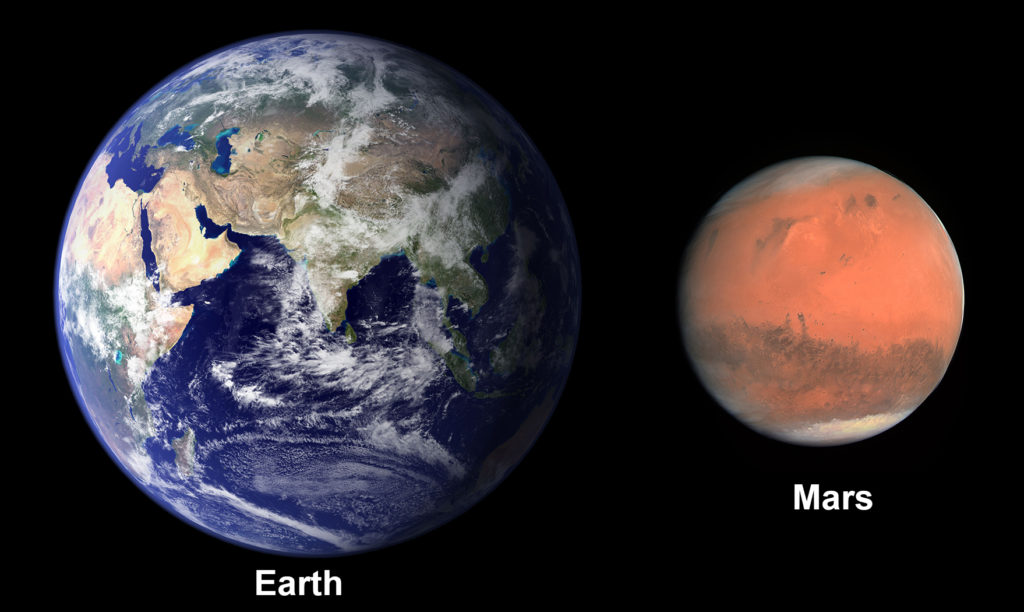
Perhaps the most noticeable differences from Earth are the complete absence of life and lack of liquid water. In fact, liquid water cannot exist on the surface of Mars for any length of time because Mars lacks sufficient air pressure. On Mars, if ice is heated above 32 degrees Fahrenheit, it will go directly to a vapor state, bypassing the liquid state entirely. It acts just like “dry-ice” (frozen carbon dioxide) does on Earth. Yet, Mars has dried riverbeds and even deltas, strongly implying that Mars had liquid water on its surface in the past. Secularists believe that this is evidence that Mars once had a much thicker atmosphere in the distant past. But could there be another explanation?
Whereas Earth’s polar ice caps are comprised of water-ice (frozen H2O), the polar ice caps of Mars are a combination of water-ice and frozen carbon dioxide. Dust storms on Mars typically cover an area for several days. But on occasion, Mars has global dust storms that wrap around the entire planet and obscure its surface features for several weeks. These global storms happen roughly every three Martian years (5.6 Earth years) and can even be seen from Earth using a backyard telescope.

Mars has volcanoes on its surface, and they are truly massive. Many of them are easily visible from space. The largest is named Olympus Mons, and is the largest known volcano anywhere. It is three times taller than Mount Everest. However, the volcanoes on Mars are shield volcanos with a very shallow slope, much like the large volcanos on the big island of Hawaii, and unlike the steeper stratovolcanoes of the American Northwest. In fact, the base of Olympus Mons would cover the entire state of Iowa.
Secularists generally believe that all of Mars’ volcanoes are extinct, and that none have erupted for millions of years. However, creationists have proposed that these volcanoes are merely dormant, and that we may see an eruption in the near future. In fact, the creation astronomer Dr. Ron Samec has proposed a model that explains the riverbeds and deltas we see on Mars using volcanoes. When a volcano erupts on Earth, it ejects a great deal of water vapor. Volcanoes on Mars may have also done so, and the ejected cloud of debris would temporarily increase the local air pressure in the vicinity to the point were water could exist in a liquid state to produce riverbeds and deltas. A future eruption might verify this model.
Mars has a massive canyon stretching east to west just south of the equator. It is named Valles Marineris after the Mariner 9 spacecraft which orbited Mars in 1971-1972 and discovered the canyon. Valles Marineris is 2500 miles long, 120 miles wide, and over 4 miles deep in places, dwarfing the Earth’s Grand Canyon. The canyon may be the result of a tectonic fissure, where the planet’s crust has cracked open. However, Mars lacks plate tectonics, which is what allows Earth’s continents to change configuration under certain conditions.
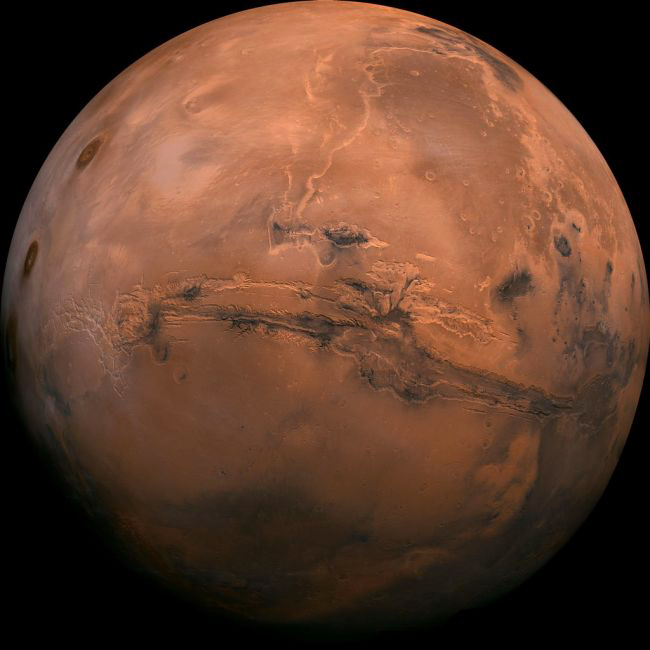
Mars lacks a global magnetic field. Earth’s magnetic field deflects cosmic radiation that would otherwise be harmful to life. But since Mars lacks such a field, any astronauts who walk on its surface will be exposed to these harmful cosmic rays. A short exposure is not a problem; we can survive such radiation for several days with no ill effects. But an extended mission to Mars will have to deal with this issue. Mars does have remanent magnetism: weak magnetic fields within its rocks that are evidence that Mars once had a global magnetic field. This is confirmation of the biblical timescale. Magnetic fields decay over time and cannot persist over millions of years.
Moons
Mars has two moons, Phobos and Deimos. They are tiny compared to the Earth’s moon. The inner moon, Phobos is only 14 miles across. That is an average number because Phobos is not quite round. In fact, most small moons and asteroids are not round – they are so small that their gravity is unable to overcome the chemical bonds and pull the little world into a sphere. Deimos is even smaller, only 8 miles across on average, and rather “potato-shaped.” The gravity on these moons is so weak, you could pick up a rock and throw it into orbit. On Deimos, you could almost jump off completely.
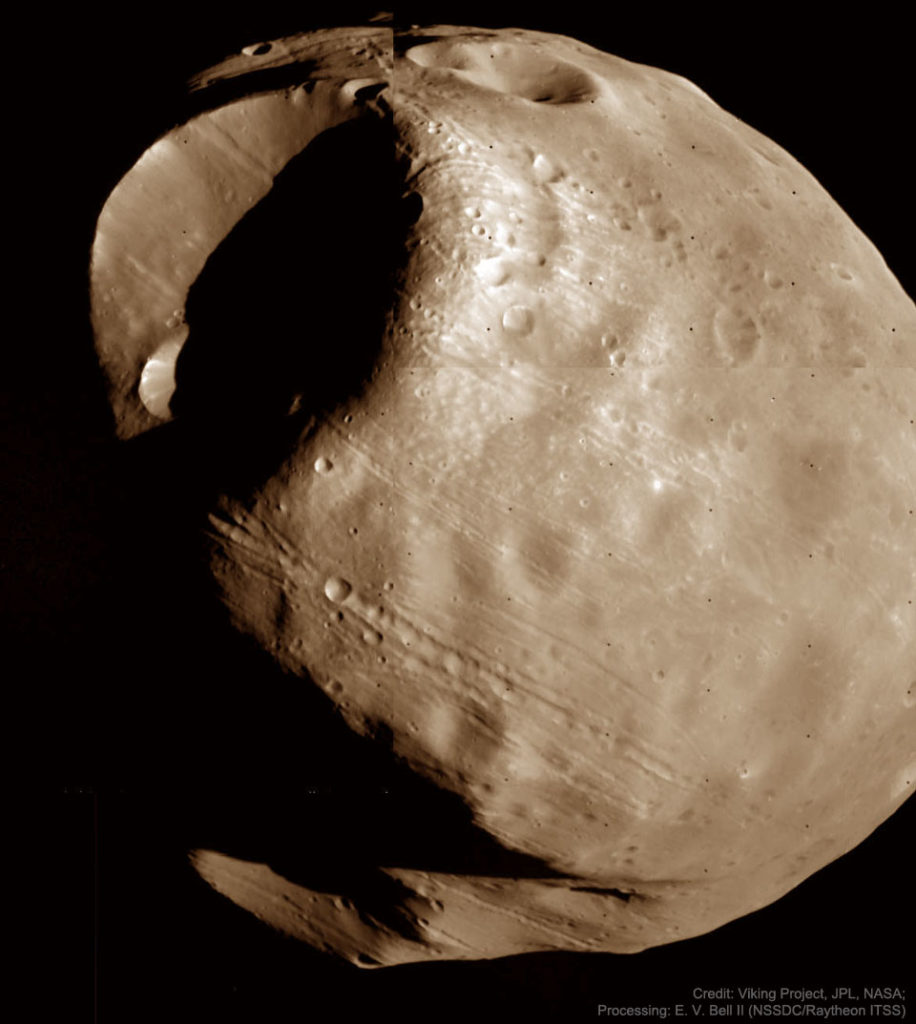
Deimos orbits Mars at a distance of only 14,500 miles. By contrast, Earth’s moon orbits at 240,000 miles. At such a close distance, Deimos takes only 30 hours to orbit Mars. Phobos orbits at a distance of only 3,700 miles from the surface of Mars – closer than any other known moon. As such, it takes only 7 hours and 39 minutes to orbit Mars – significantly faster than Mars rotates. Both moons orbit prograde – in the same direction Mars rotates. Both are tidally locked, rotating at the same rate they revolve and hence keeping the same face toward Mars. If you were standing on the Mars-facing hemisphere of Phobos, Mars would fill over half the sky. The view would be spectacular. The names Phobos and Deimos mean fear and terror respectively. These were chosen because Mars is named after the Roman god of war.
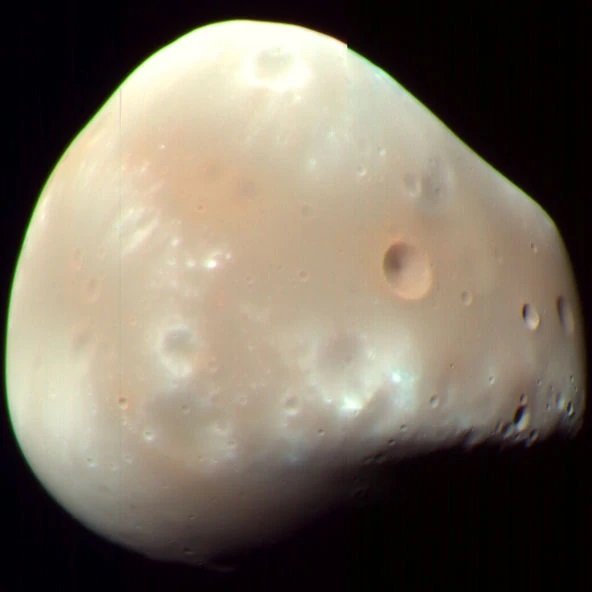
Observing Mars
It is very easy to see Mars from Earth. Whereas the inner planets Mercury and Venus are best observed when at greatest elongation (when they are farthest from the sun in angle) either just after sunset in the western sky, or just before sunrise in the eastern sky, outer planets are best viewed at opposition. Opposition means the planet is in the opposite direction in Earth’s sky than the sun is. Consequently, at opposition an outer planet rises around sunset, and sets at sunrise, and is therefore visible all night. A planet at opposition reaches its highest point in the sky at midnight, when the sky is darkest. Furthermore, celestial objects look best when they are high in the sky because the light travels through less of Earth’s distorting atmosphere than when the object is near the horizon. Mars is easily visible to the naked eye. It is noticeably red, and becomes extremely bright around the time of opposition.
For most outer planets, opposition occurs annually.[1] This is the because most outer planets orbit the sun very slowly due to their extreme distance, and therefore the Earth passes them roughly once every year. Furthermore, since most outer planets never come very close to Earth, and since they are all quite large, they look quite bright and large in a telescope for several months before and after opposition. So, if you have access to a small telescope, every year you will be treated to spectacular views of the outer planets for several months. Mars is the exception to all these trends.
Since Mars orbits only 52% farther from the sun than Earth and orbits the sun once every 1.88 years, Mars undergoes opposition every 2.1 years when Earth passes it. Furthermore, the distance between Mars and Earth varies widely. At their greatest distance, Mars and Earth are 250 million miles apart. This configuration happens at conjunction, when Earth is at point E and Mars at point F as illustrated in the figure below. However, Mars can come as close as 34 million miles from Earth at opposition, as when Earth is at point A and Mars at point B in the figure. At such a time, Mars will appear 7.3 times larger in a telescope than when the two planets are farthest apart – and 54 times brighter! For comparison, Jupiter is only 1.5 times larger at closest approach than it is at farthest distance from Earth.
So, with a backyard telescope, you can get a decent view of any outer planet about six months out of every year. But since Mars is a small planet, and increases in size 7.3 times at opposition, it only looks impressive in a small telescope for a few weeks around the time of opposition, which only happens every 2.1 years. At other times, it appears very small and relatively faint. So, when Mars does undergo opposition, take advantage of it.
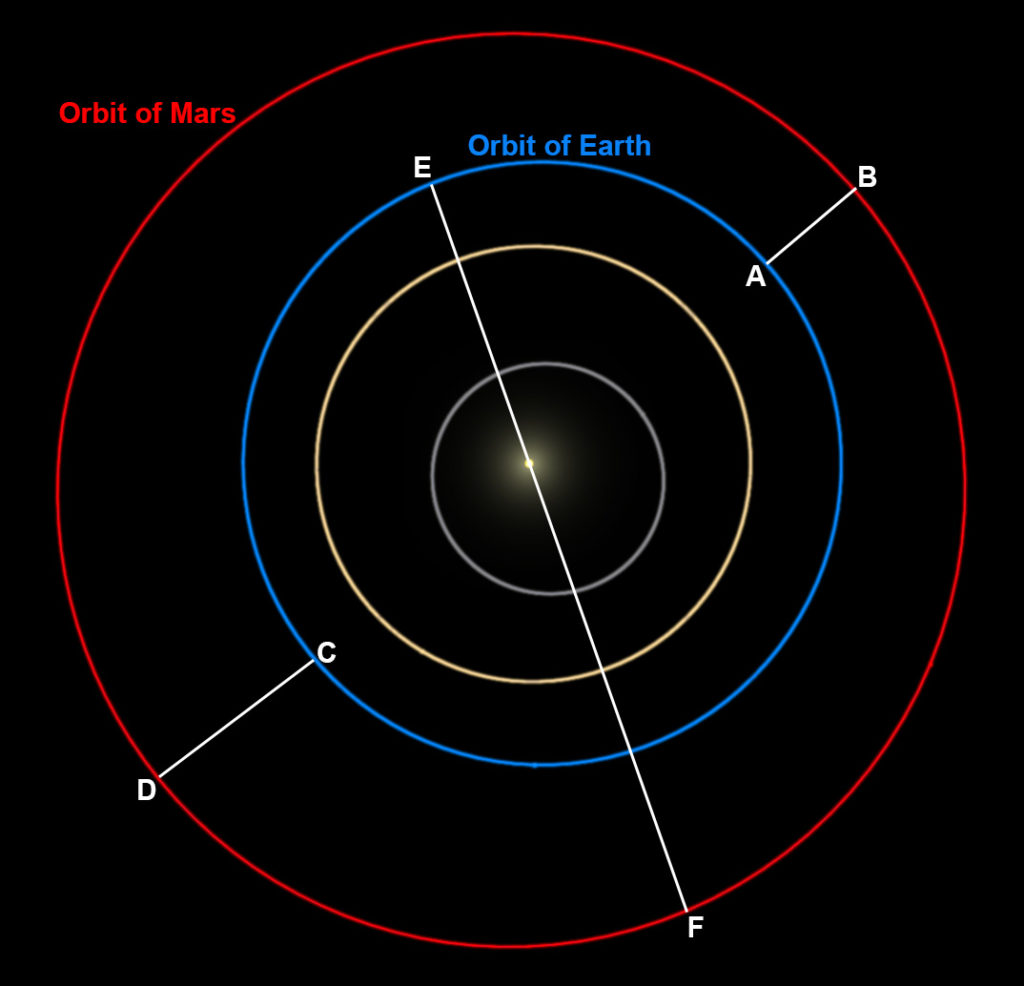
The situation becomes even more interesting when we consider that not all Mars oppositions are equal. The orbit of Mars is noticeably elliptical. So, sometimes when Earth passes Mars, the two are extremely close because Mars is near its perihelion (its closest point to the sun) – at point B in the above figure. At other oppositions, Mars is near its aphelion (farthest point from the sun), and therefore is not as close to the Earth. This is illustrated above when Earth is at point C and Mars is at point D.
So, Mars oppositions happen roughly every other year, and some years are better than others. At the time of publication of this article, we are in for a good year; Mars reaches opposition in August 2020 and will be closest to Earth on August 6th at a distance of 38.6 million miles. Particularly good oppositions occur in groups of two or three every 15 or 17 years.
At opposition, Mars looks wonderful as seen through a backyard telescope. Surface features are usually visible such as the dark Syrtis Major or the very bright Hellas. One of the two polar caps is often visible as a patch of white contrasted against the dark red disk. Sometimes people will see two white patches, and mistakenly think they are seeing both polar caps. But in reality, only one cap can be seen at a time. The other white patch is Hellas – an enormous valley that often fills with fog and surface frost making it appear bright. Since Mars rotates at about the same rate as Earth, you can watch its features rotate along the disk as the night progresses. These are features are almost always visible unless you happen to catch Mars during one of its global dust storms. Such storms obscure virtually all features, and give Mars the appearance of a bland uniform red/orange.

With some skill and patience, it is possible to see both of Mars’s moons in a backyard telescope – but only when Mars is near opposition. This isn’t easy for beginners however. The moons of Mars are faint, but not all that faint. They are plenty bright enough to be detected in a very modest telescope. The problem is that they are so close to Mars, and Mars is 200,000 times brighter! It is difficult to see something so faint next to something so bright. There are two tricks to seeing Mars’s moons. First, figure out the time when they are farthest in angle from Mars. Various software and internet tools can compute these times. Second, move the telescope so that Mars is just barely outside the field of view. This will allow you to see the much fainter moons. Alternatively, you can buy or construct an occultation bar at the focal point of the eyepiece, which blocks the central region of the field of view, revealing the fainter objects around it. Phobos is particularly fun to watch because it moves so fast. On one evening, you can see Phobos on the right side of Mars, and then less than four hours later on the left side of Mars! Few things in astronomy change so rapidly.
A Day on Mars
What would it be like to be one of the first astronauts to live in a base on Mars? The one-third gravity might be fun, especially when inside your cabin, unencumbered by a spacesuit. Looking out your window, the sun would rise in the east, just like on Earth. However, the sky surrounding the sun would appear blue due to the thin atmosphere, not red like sunrises on Earth. On a windless day as the sun rises higher, the entire sky would appear blue, but a darker blue than we see on Earth. The sun appears slightly smaller than it does on Earth, and shines only half as bright due to its greater distance.

After a healthy breakfast of potatoes, you might want to go for a walk and explore the landscape. But it’s not as easy as on Earth. You must first put on a spacesuit that carries sufficient oxygen and water since you cannot breathe the thin air on Mars. You would have to go through an airlock that would depressurize to match the Martian air pressure.
Outside the base, Mars appears as a red, lifeless desert with nothing but rocks as far as the eye can see. Some areas of Mars are as flat as Kansas, with no hills or valleys of any kind. But fortunately, your base is near some hills. But they are very shallow sloping. Mars does not have the steep cliffs and rugged terrain of Earth. In the distance, a dust devil kicks up some red dust. You would have to be careful not to tear your spacesuit. The smallest rip would allow the oxygen to escape, and you would have only minutes to try to get back inside your base before you asphyxiate.
That evening, the sun sets in the west, just as it would on Earth. The sky becomes very dark. A bright bluish star is low in the southwest – that’s Earth. Aside from your fellow astronauts, everyone you know is on that pale blue dot. Extremely close to the Earth is a fainter star – the Earth’s moon. As the night progresses, the stars rise in the east and set in the west, just like on Earth. But the constellations appear shifted. They do not revolve around the north star, but instead revolve around a point just north of the constellation Cygnus – that’s true north for Mars.
As the evening progresses, the stars continue to drift across the sky and set in the west. But you might be surprised and amazed to see one very bright crescent rising in the west, moving opposite the other stars like a lone salmon swimming upstream. That’s Phobos. Like Earth’s moon, Phobos orbits prograde, moving from west to east relative to the background stars. But Earth’s moon moves far slower than Earth rotates, and so our moon “loses to rotation,” rising in the east and setting in the west. But Phobos orbits faster than Mars rotates and therefore beats the rotation, slowly rising in the west and setting in the east, five and a half hours later.
Nearly three hours after its rising Phobos passes overhead and would appear about one third the size of the Earth’s moon as it appears in our sky. The phase has changed as well. Phobos is now in a slightly gibbous phase, just past first quarter. Phobos takes less than 8 hours to go through its phases. Although, the distinctly non-round shape of Phobos makes its exact phase difficult to discern by eye. You might notice the much smaller and fainter moon Deimos. Deimos also appears to be swimming upstream – west relative to the background stars. But Deimos loses to the rotation of Mars, and so it gradually drifts westward.
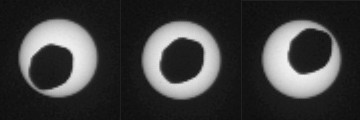
Although you might want to stay up to watch Phobos set in the east, you decide to go to bed in order to be well-rested for the next day. You might want to sleep in a bit, and since Mars has rotational period of 24 hours and 37 minutes, you can sleep in an extra half-hour every day, without ever having to “pay it back.” The sunrise tomorrow will occur a half-hour later than the sunrise today, and so on, as long as you are on Mars. Since most people like to be awake during the day, you might have a “Mars clock” that ticks 2.5% slower than Earth clocks, so that noon occurs at the same “Martian time” every day.
It would certainly be a strange and wonderful experience to live for some time on Mars. But I suspect that any future astronauts would also be happy to return to the beauty and richness of Earth. There just isn’t anything quite like walking outside without any thought of radiation or bringing air to breathe, to enjoy observing the birds, flowers, steep mountains, waterfalls, and many other treasures. Mars has its own desolate beauty, but it isn’t designed for life.
A world with many similarities to Earth, Mars has many differences as well. The universe is characterized by worlds with similarities and differences. This makes science possible. We can systematically classify types of planets, stars, rocks, minerals, plants, animals, atoms, and molecules according to their similarities and differences. But such similarities with differences also reflect the triune nature of the biblical God. The Father, the Son, and the Holy Spirit are different persons, but the same God. The universe in many ways reflects the nature of its Creator. More to come.
[1] Namely, the time from one opposition to the next is just over one year. For Jupiter, the time is 13 months.

